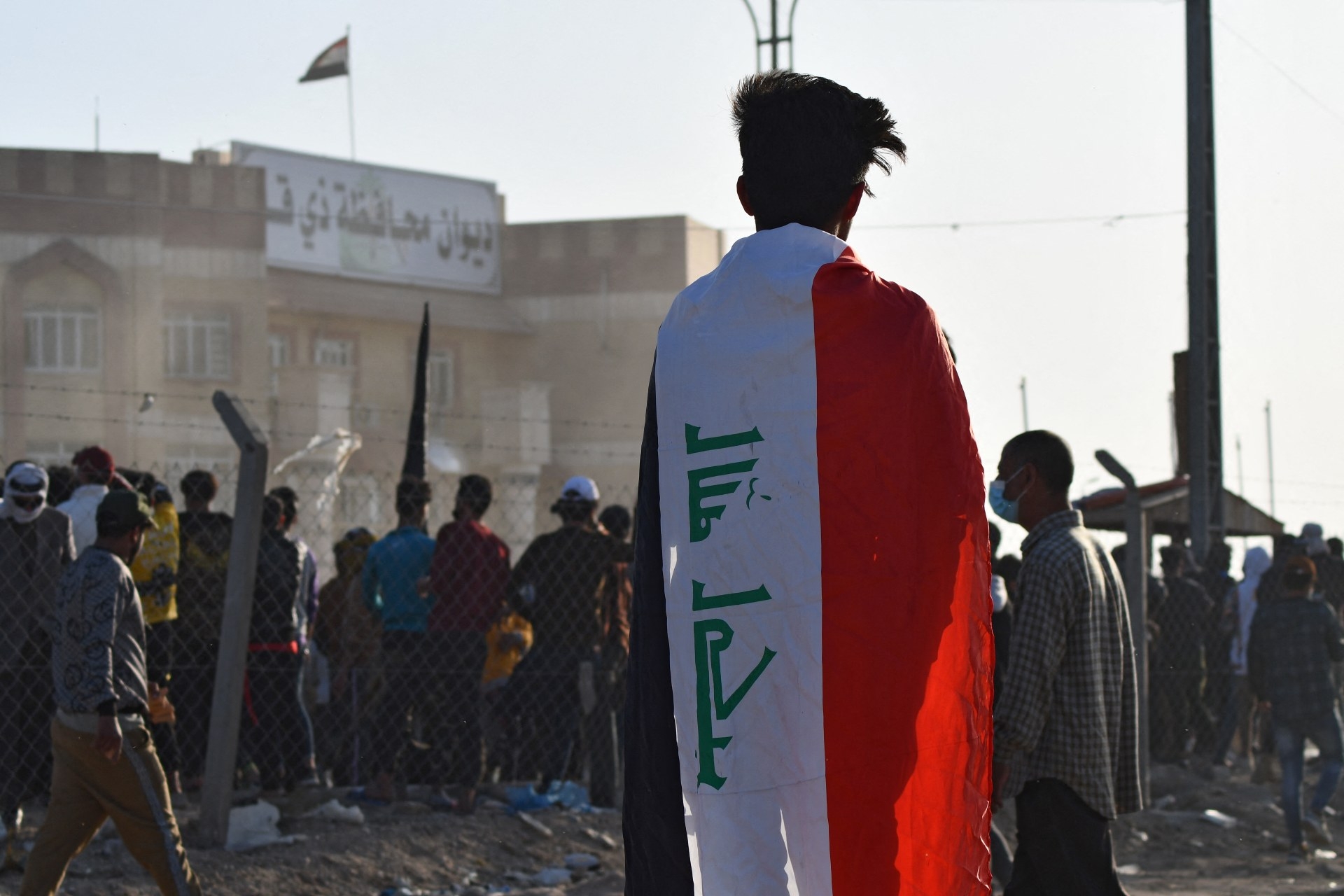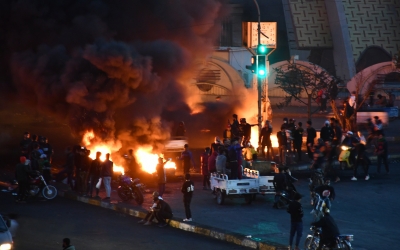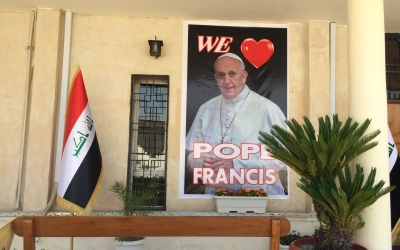Iraq's Nasiriyah calmed by Kadhimi for pope's visit - but violence likely to return

At the ancient city of Ur, recent days have seen a flurry of activity. Pope Francis’s impending visit to the site, believed to be the birthplace of Abraham, is set to be one of the most important moments of his historic four-day visit to Iraq.
Seventeen kilometres south, however, unrest has been roiling. Last week, violent clashes between anti-government demonstrators and security forces erupted in the city of Nasiriyah, with at least five protesters killed and dozens more wounded, including security personnel.
For Prime Minister Mustafa al-Kadhimi, the protests in the capital of the southern Dhi Qar province couldn’t have come at a worse time, when the world’s eyes were trained on Iraq and its ability to host the sensitive papal visit.
Yet just when it looked like the deadly unrest could upend Francis’s tour, Kadhimi has managed to quell the protests and keep a lid on a potential crisis, Iraqi officials, politicians and activists told Middle East Eye.
Crucial days
New MEE newsletter: Jerusalem Dispatch
Sign up to get the latest insights and analysis on Israel-Palestine, alongside Turkey Unpacked and other MEE newsletters
The next few days will be critical. On Friday, the pope touches down on Iraqi soil, beginning the first papal visit to the country that will see him visit Baghdad, Erbil, Najaf and Mosul.
At Ur on Saturday, Francis will hold an interfaith ceremony, part of his efforts to boost interreligious relations in Iraq. The resumption of demonstrations in Nasiriyah and the clashes between protesters and the security forces doubled the fears of the trip’s organisers, who were worried they could not guarantee the safety of the pope, his companions, and the religious delegations meeting him.
Kadhimi had to move swiftly, and he did. The prime minister dismissed Dhi Qar governor Nazem al-Waeli "in response to the protesters’ request”, and assigned Lieutenant General Abdul Ghani al-Asadi, head of the National Security Agency, as acting governor until the protesters agreed to a replacement.
Meanwhile, counter-riot forces and local police were pulled from the city and replaced by the army. An advisory council linked to the premier was also launched, tasked with solving the governorate’s problems, and a federal probe was formed to uncover those responsible for the deadly attacks on protesters.
As Asaidi took over, calm and control returned to Nasiriyah after five days of violence. Asadi immediately began extensive discussions with tribal heads, activists and dignitaries, handing them the task of starting a dialogue to name a new governor. Meanwhile, the former counter-terrorism commander embarked on a rapid renovation process that included the ancient city of Ur and the roads leading to it.
'The people of Nasiriyah are aware of the importance of the pope's visit to their city and to the country as a whole'
- Hassan Nadhim, culture minister
“We know that Nasiriyah was the source of the first spark that was set off to bring down the previous government, and we know that the city has a special status, but the government took care of Nasiriyah not because it is a source of this [threat], but because it needs special attention,” Hassan Nadhim, the culture minister and official spokesman for the Iraqi government, told Middle East Eye.
Nadhim stressed that nothing would endanger the pope’s visit, and Baghdad and the Vatican were determined to make it successful.
"The demands of the demonstrators are legitimate and this government, since its formation in June, has taken care of neglected cities, described them as afflicted, and allocated funds for their reconstruction,” he said.
"We know that there are those who are using the current situation [in Dhi Qar] for their own purposes... But we believe that these events [the violence] have nothing to do with the pope's visit. The people of Nasiriyah are aware of the importance of this visit to their city and to the country as a whole.”
The origin of the conflict
Dhi Qar governorate and its capital, Nasiriyah, which is located on the left bank of the Euphrates river, is the cradle of the Sumerian civilization. Its people are known for their tendency to revolt and stubbornness in the face of authority.
Most opposition political movements in Iraq’s modern history were launched from the area, including the Communist Party that overthrew the monarchy in the 1950s and the Baath Party, which then brought down that government in the 1960s.
It later became a hub for the Shia armed groups that challenged the rule of Saddam Hussein, with its marshes used as sanctuaries after attacks carried out on party headquarters and security services in the region. The 1991 Shia uprising, which was brutally repressed by Saddam, also began in Dhi Qar.
During 2019’s massive anti-government demonstrations, the province’s protesters were seen as the “icons of the sacrifices”, as Nasiriyah suffered the highest death toll of any city outside Baghdad. The massacre committed by the security forces in the city on 28 November 2019, in which 32 protesters were killed and 225 others were wounded within just two hours, led to the downfall of Prime Minister Adel Abdul Mahdi and his government.
Those bloody events forced the former governor of Dhi Qar, Adel Al-Dakhili, to resign as well. And the major political and armed factions in Nasiriyah were beaten back into a retreat: most of their headquarters were either bulldozed or torched.
Despite promising protesters they would not interfere in the governor’s matters or reopen offices in the city, those powerful political forces refused to relinquish Nasiriyah.
Instead, they began to use the demonstrators themselves as tools to undermine the newly assigned Waeli, activists, local and federal security officials told MEE.
Waeli, a judge who was introduced to the protesters as an independent, was soon adopted by the Sairoon bloc, influential Shia cleric Muqtada al-Sadr’s political wing. He quickly replaced most of Dhi Qar’s top officials with people loyal to Sadr.
Some of those replaced officials were in lucrative positions, where service contracts could be awarded in return for millions of dollars. Each of these officials either belonged to an influential political force, or was at least allied to one.
In August, the government allocated a 50bn dinar ($34.2m) emergency grant to Nasiriyah "to improve the services situation in the city”, which prompted the political factions to resume their jostling for positions and influence, seeking a slice for themselves. Suddenly, the position of governor took on new importance.
“The first demonstration in Nasiriyah nearly 10 days ago [23 February], which demanded the dismissal of the governor, was led by the office manager of one of the former department directors, who was dismissed by Waeli,” said a local intelligence officer involved in the investigations into the latest violence in the city.
"Our information indicates that the aforementioned person paid money to a number of youths to attack the governorate building. The number at the beginning was small, but [the police’s] killing one of them angered the rest of the protestors, who had distanced themselves from that demonstration at the beginning,” added the official, speaking to MEE on condition of anonymity.
“Events escalated over the following five days, and ended as they did.”
All the activists and local and federal officials, including two commissioners of the Iraqi High Commission for Human Rights (IHCHR), MEE spoke to for this story corroborated the intelligence officer’s version of events.
Coopting youth
The youths coopted on that first day of demonstrations come from very deprived backgrounds, sources said. Most were teens, some as young as 11, and the vast majority were unemployed.
“They were paying these young men 50,000 dinars ($33) to attack the building and the security services with stones and cut the streets with burning tires," the intelligence officer said.
The officer said regular protesters are easy to spot and familiar to the security services. They introduce their representatives and give demands in a polite manner, he said.
"Matters do not descend into violence except when something happens that provokes them, but these protesters were attacking the security personnel fiercely and without prior indication, deliberately colliding with them,” the officer said.
'The ongoing struggle between political forces over the position of the governor used youth as fuel. This is the story in a nutshell'
- Prominent activist
"The problem is that our security personnel deployed in the streets, including the riot police, are not professionally qualified to confront and contain such behaviour, and this always causes losses between the two parties."
By the end of the fifth day of the demonstrations, six protestors were killed and 271 others wounded, including 147 security personnel, according to IHCHR records.
“Unfortunately, there has been a dangerous shift in the demonstrations in Nasiriyah. The ongoing struggle between political forces over the position of the governor used youth as fuel. This is the story in a nutshell," a prominent activist in the city told MEE.
The activist, who declined to be named for security reasons, said competing political forces had been using demonstrators as tools in recent months. Tactics, he said, included infiltrating protests with their supporters, as well as buying off poor youths.
“The problem is that the real activists and demonstrators are subjected to systematic terminations,” the activist said, warning it had become difficult to isolate agitators.
"We are between two fires, and the actual beneficiaries of everything that is happening are the political forces that penetrated the demonstrators and are manipulating them, with or without their knowledge.”
Fraught discussions
The Sadrists are at the forefront of the conflicting political forces in Nasiriyah, followed by the Badr Organisation, the Islamic Virtue Party, Asaib Ahl al-Haq and the al-Hikma Movement. Although all of these forces have political and security influence in the governorate, the Sadrists are the most inclined to use violence to achieve their goals, local and federal officials and activists told MEE.
Assigning Asadi exclusively to the task of managing the governorate’s affairs during this sensitive period was not arbitrary, as he has security and military experience and is fully supported by the Sadrists. His choice has sent reassuring messages to them that none of their opponents will occupy the position at this stage, lawmakers and federal officials told MEE.
“Asadi is originally from Nasiriyah and is supported by the Sadrists and enjoys good tribal relations in the region, so the choice was smart,” a lawmaker originally from Nasiriyah told MEE.
"A person of such characteristics with broad security and administrative powers is the most capable of confronting the conflicting forces, at least until the pope's visit ends.”
Discussions over the new governor began a few days ago in the Nasiriyah home of Sheikh Hussein Ali al-Khayoun, the emir of the al-Aboudah tribe, one of the largest in Dhi Qar and one of those close to Kadhimi. They have been attended by representatives of the old political forces and the demonstrators.
Initial indications do not bode well, lawmakers, security and federal officials told MEE, warning that clashes could break out again at any time.
"Kadhimi succeeded in dismantling the crisis and neutralised the parties that inclined to violence [the Sadrists] by sending Asadi there. This cannot be denied,” a lawmaker involved in the ongoing talks to calm the situation told MEE.
"Everything that has happened and what may happen is not aimed at cancelling the pope's visit. The aim is to use the timing to blackmail Kadhimi and obtain some gains," he added.
"It is clear that he [Kadhimi] played with all the parties according to their rules. The demonstrations may return, but they will not be with the same momentum and strength as long as the big players remain far from the arena.”
Middle East Eye delivers independent and unrivalled coverage and analysis of the Middle East, North Africa and beyond. To learn more about republishing this content and the associated fees, please fill out this form. More about MEE can be found here.







